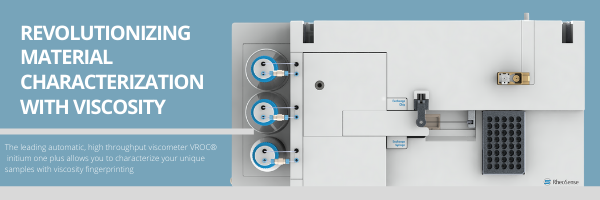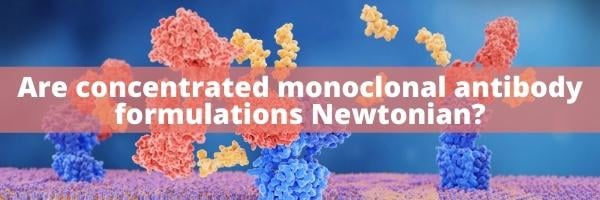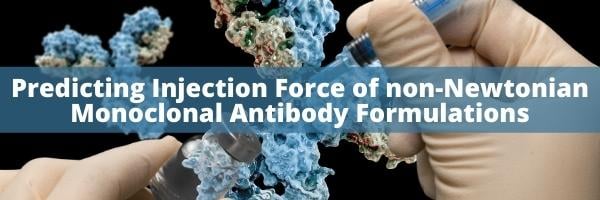One of the most common uses of viscosity is to assess the ability to deliver pharmaceutical formulations to the patient by injection. A significant component of formulation research and development is rheology modification to ensure that therapeutics can be delivered without an excessive injection force. This concern is especially important when developing high concentration monoclonal antibody solution (mAb) formulations because the viscous response of these high concentration solutions can vary significantly due to differences in PPI and buffer composition.
It is often assumed that most mAb solutions are Newtonian, and that only a few unusually strong attractive mAbs exhibit shear thinning behavior. This assumption of a Newtonian viscosity may be rationalized because of primary antibody size (i.e. 5 – 6 nm) and the inability of the molecules to significantly overlap or entangle at elevated concentrations like linear polymers. The assumption that mAbs solutions are Newtonian often leads to viscosity screenings that are performed at a single low shear rate.
Shear rates experienced during injection can vary significantly depending on the needle gauge utilized and time required to deliver a particular volume. Therefore, exploring viscosity of mAbs over a broad range of shear rates to identify non-Newtonian behavior can be crucial to predicting all aspects of performance of these high concentration injectable solutions, including stability and delivery.

The RheoSense team conducted and experiment to assess the likelihood of shear thinning for mAbs and the importance of measuring beyond a single point viscosity. Using the VROC® initium one plus, our research and development team measured the viscosity of mAbs over a broad range of shear rates to determine if, and when, non-Newtonian behavior is observed.

The measurements our team collected disapproved the belief that mAb solutions are Newtonian by demonstrating that almost all mAb solutions are non-Newtonian shear thinning. The data also suggests that well known colloidal rheology can be a useful tool to understand the viscosity behavior of mAb.
Download our application note “Are concentrated monoclonal antibody formulations Newtonian?” to see the full analysis and data obtained from our measurements.
The data obtained demonstrates a few critical points and practical applications of shear thinning behavior of mAb solutions:
- Viscosity must be measured at high enough shear rates to accurately assess injectability. The outdated general practice of measuring viscosity at low shear rates is clearly not sufficient and one could go as far as to say it is indeed “bad” science.
- To estimate injection force accurately you must measure the whole viscosity vs. shear rate curve. Accurate estimation of injection force at the early stage of development is a tremendous cost saving and helps to ensure that suitable therapeutic candidates are not discarded but continue to move forward in the development process.
- We can decipher interactions between mAb molecules, or protein-protein interactions (PPI) without dilution from the analysis of the viscosity vs. shear rate curve with Pe (Peclet number) borrowed from the colloid rheology. This analysis method is useful to understand how to formulate to reduce PPI.
In a continued collaboration with Comera, shear rate dependent viscosity data was collected with the VROC® initium one plus for eighteen mAb formulations to predict the injection force and compare to the corresponding injection or glide force measurement data.
Download our application note “Predicting Injection Force of Non-Newtonian Monoclonal Antibody Formulations” to see the full analysis of data obtained and comparison to experimental results.
Written by: Dr. Seonggi Baek, RheoSense CEO, and Dr. Stacey Elliott, RheoSense Principal Scientist




